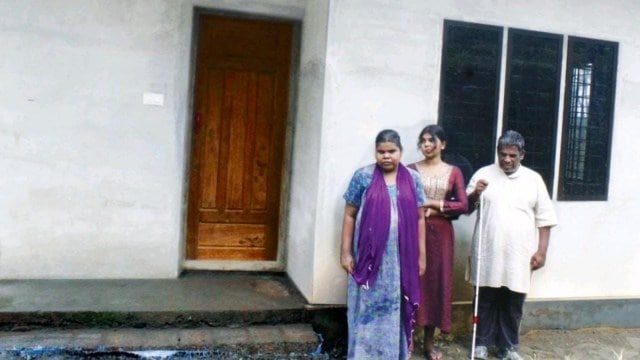Homes, medicine, food kits: Behind Kerala’s ‘extreme poverty eradication’
In 2021, the local self-government department, the nodal agency for implementing the scheme, trained nearly 4 lakh people, including officials, elected representatives and volunteers to identify families facing extreme poverty.
 Visually impaired couple Shai Varghese and Sunitha with daughter Teena in front of their house which they got under the Extreme Poverty Eradication Programme. (Special Arrangement)
Visually impaired couple Shai Varghese and Sunitha with daughter Teena in front of their house which they got under the Extreme Poverty Eradication Programme. (Special Arrangement)On November 1, Kerala will declare itself “the first state in the country to eradicate extreme poverty”. The declaration comes at the end of four years of a targeted welfare push led by local bodies under the state government’s Extreme Poverty Eradication Programme (EPEP).
In 2021, at the end of a state-level survey, the CPI(M)-led Left Democratic Front government identified 59,000 families across the state as “extremely poor”. Over the next four years, micro plans, tailored for each family, were executed through local self governing bodies in the state.
Among the beneficiaries is Sathyavathi. A chronic heart patient, Sathyavathi lived alone in Kuttiattoor panchayat in Kerala’s Kannur district and had been struggling to pay for her monthly medication. But since 2024, a box with medicines worth `1,600 has been arriving at the 67-year-old’s house.
In the same panchayat, K K Hamza, 49, who has been wheelchair-bound since a road accident 15 years ago, now runs a shop for which the local body arranged for sponsorship. The panchayat also ensures that he gets regular palliative care.
In February 2024, Kuttiattoor panchayat was declared the first local body in the state to be free of “extreme poverty”.
Minister for Local Self Governments, Rural Develop-ment M B Rajesh told The Indian Express, “Kerala is the only stat in the country that has ventured to eradicate extreme poverty after identifying the poor through a survey.” The poverty alleviation programme was one of the first decisions taken by the Pinarayi Vijayan government after it assumed office for its second consecutive term in May 2021.
There are two broad, established means to determine poverty in India — the World Bank’s poverty line of $3 a day (or `62 a day when calculated on purchasing power basis) and NITI Aayog’s multidimensional poverty index. While the latter is increasingly being relied on to determine poverty in the country, the Kerala government says its survey relied on neither. Sources said no decision has been taken on whether the survey, the first of its kind in the state, will be held periodically.
According to the NITI Aayog’s index published in 2021, with just 0.55% of its population being classified as multidimensionally poor, Kerala is the least impoverished state in India. It’s this “microscopic minority living in extreme poverty” that the state sought to target, said minister Rajesh.
In 2021, the local self-government department, the nodal agency for implementing the scheme, trained nearly 4 lakh people, including officials, elected representatives and volunteers to identify families facing extreme poverty.
After field visits and focus-group discussions, a preliminary list of 1,18,309 families who had been left out of various welfare schemes was prepared. The list was whittled down to 64,006 after several rounds of verifications, and further down to 59,000 families after accounting for deaths and migration.
Dr Joy Elamon, former Director-General of Kerala Institute of Local Administration whose team prepared the guidelines, said, “The survey to prepare the list of the extremely poor was held at the grassroots level with people’s participation. At each ward/division, brainstorming sessions were held to find distressed families in their neighbourhood and the reasons were identified. Apart from field visits, the lists were cross-checked multiple times to zero in on the deserving.”
Micro-plans were then prepared for each of the families to address issues related to shelter, health, food, education and income. Next, various departments were tasked with providing the distressed families the service or welfare scheme they required.
“Before designing the survey, we looked into the drawbacks of the existing methods of identifying poverty. The focus of our survey was to identify the real poor and the reasons behind their distress. We have several existing welfare schemes that are general in nature. Many people in distress may not find a place in such schemes. For example, a bed-ridden person living alone may not be able to cook food. The mother of a differently abled child may not be able to go for work to run the family,” Elamon said.
As part of the programme, the state also launched the Avakasam Athivegam (rights fast) campaign to ensure that all beneficiary families had the necessary civic documents (like MGNREGS job card, voter ID, Aadhaar card, bank accounts and social security pension) and essential services (electricity, cooking gas connections, etc.).
The survey had identified 4,677 families as homeless, of which 4,005 have been provided homes under the Life Mission, the government’s scheme for the homeless. “People were encouraged to donate land to landless families. We also asked the District Collectors to identify the land,” said minister Rajesh.
Of the 59,286 families, 20,648 were identified as those who had no regular food supply. Local bodies across the state then supplied meals.







